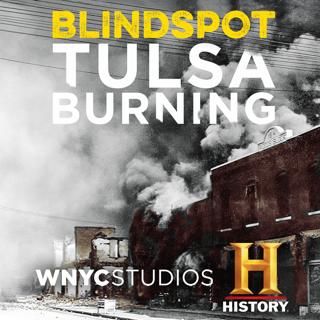
Blindspot introduces Dead End: A New Jersey Political Murder Mystery
Blindspot introduces a new podcast: Dead End: A New Jersey Political Murder Mystery New Jersey politics is not for the faint of heart. But the brutal killing of John and Joyce Sheridan, a prominent couple with personal ties to three governors, shocks even the most cynical operatives. The mystery surrounding the crime sends their son on a quest for truth. Dead End is a story of crime and corruption at the highest levels of society in the Garden State. Jim O'Grady (Blindspot, Season 1) in conversation with investigative reporter and Dead End's host, Nancy Solomon.
2 Juni 20220s

Revisiting 9/11
Twenty years after the attacks that changed our world, we revisit the evidence and question the people at the center of the story.
1 Sep 20210s

Episode 6: The Lesson
The centennial of the massacre attracted international coverage; camera crews, T-shirt vendors, and even a visit from President Joe Biden. It seemed as though all this attention might ensure that history finally, would never be forgotten. But a month later some Tulsans worry that a backlash has begun. The city’s mayor and other elected officials have spoken against reparations for victims of the massacre and their descendents. A new law in Oklahoma limits how teachers can teach the massacre in schools. "If you care about the history of America's Black victims of racial violence,” says educator Karlos Hill, “You live in the world differently than if you are indifferent or simply ignorant about it." EPILOGUE In the days following the massacre, some 6,000 Black residents were forced to live in internment camps and many were made to clean up the destruction of their own community. The Red Cross set up tents and hospitals; they stayed for nearly six months. Many people and organizations outside of Tulsa sent money and other contributions. Soon after, Tulsa’s city officials declined any additional aid saying that what happened “was strictly a Tulsa affair and that the work of restrictions and charity would be taken care of by Tulsa people.” Nearly half of Greenwood’s residents left, never to return. But those that remained rebuilt Greenwood and many say it came back even stronger. That is, until the 1960s, when the city allowed a highway to bisect the neighborhood. Like so many other thriving Black communities, Greenwood was divested from and disenfranchised. The people featured in this podcast series who survived the massacre went on to live rich and varied lives: Mary Elizabeth Jones Parrish—the journalist whose book Events of a Tulsa Disaster is a primary source for much of what we know about the massacre—taught high school in Muskogee and ultimately returned to Tulsa. Buck Colbert Franklin—one of the first Black lawyers in Oklahoma and who served Greenwood residents from an internment camp tent following the attack—practiced law for more than 50 years. He published his autobiography My Life and An Era with the help of his son, the legendary civil rights leader and historian John Hope Franklin. A.J. Smitherman—the crusading newspaper publisher of The Tulsa Star—lost his home and newspaper offices in the attack. He was among the dozens of people indicted for the massacre, blamed for inciting the violence. He fled east, ultimately to Buffalo, New York, where he founded another newspaper, The Buffalo Star. He never returned to Greenwood and died in 1961, at age 77. Nearly fifty years after his death, Tulsa County finally dropped the charges against him. Mabel Little—who ran a beauty salon in Greenwood—also lost everything during the attack. In the years afterward, she and her husband Pressley built a modest three-bedroom house and adopted 11 children. Pressley died in 1927 from pneumonia; Mabel blamed the massacre for his declining health. In her later years, she was a tireless activist for desegregating Tulsa’s public schools. When she died in 2001, she was 104 years old. Learn more about Greenwood and the massacre: Riot on Greenwood: The Total Destruction of Black Wall Street by Eddie Faye Gates Riot and Remembrance: America’s Worst Race Riot and Its Legacy by James S. Hirsch Reconstructing the Dreamland by Alfred L. Brophy Death in a Promised Land: The Tulsa Race Riot of 1921 by Scott Ellsworth
2 Juli 202133min

Episode 5: The Body
This episode contains descriptions of graphic violence. Ignored, erased, silenced… But Greenwood’s trauma from 1921 persists. Resmaa Menakem — a therapist and expert on healing from conflict and violence — explains how generations of people pass down the experiences of historical events, and how racialized trauma affects us all, no matter our skin color. He and KalaLea ask, how might healing happen for the descendants of survivors and perpetrators of the massacre?
25 Juni 202131min

Episode 4: The Massacre
This episode contains descriptions of graphic violence and racially offensive language. Over two days — May 31 and June 1, 1921 — a mob of white attackers systematically looted Greenwood and burned it to the ground. Estimates vary, but reports say the marauders killed 100 to 300 people; and they left thousands homeless, faced with the daunting task of rebuilding. We experience the attack through the eyes of lawyer B.C. Franklin and reporter Mary Elizabeth Jones Parrish — each left personal, comprehensive written accounts of those terrible days. We also hear how their experiences have affected their descendants. “They had a lot of family trauma,” says Parrish’s great-granddaughter Anneliese Bruner. “Some of these are behaviors that arise because of the chaos that is passed down from generation to generation. The responses and the symptoms are just the outward manifestation of the suffering that people are enduring and carrying around.”
18 Juni 202139min

Episode 3: The Two Wars
This episode contains descriptions of graphic violence and racially offensive language. When the U.S. entered World War I, W.E.B. DuBois and Tulsa lawyer B.C. Franklin saw a rare opportunity: Black Americans serving in the military might finally persuade white citizens that they deserved equal respect. But the discrimination they faced in civilian life continued in the trenches and on the homefront. After the war, white mobs plundered and burned Black neighborhoods throughout the country. And during the “Red Summer” of 1919, whites lynched more than 80 people, including Black veterans. Groups like the African Blood Brotherhood responded by urging people to defend themselves — with force, if necessary. On May 31, 1921 the fight arrived in Greenwood.
11 Juni 202139min

Episode 2: The Rise of Greenwood
The people beyond Greenwood’s borders ensured that the neighborhood could not prosper for long. To understand how and why, we travel back to the Trail of Tears and the forced resettlement of five Native American tribes. We examine the racist laws and policies that shaped the area. Despite Jim Crow segregation, the district flourished -- it even came to be called “Black Wall Street.” “The story of Greenwood is so complex,” says writer Victor Luckerson. “There's so much tragedy and trauma as part of it, but also so much inspiration.” We also meet the journalist A.J. Smitherman, legendary publisher of The Tulsa Star (one of the first Black daily newspapers in the United States) and a fierce advocate for his community.
4 Juni 202135min

Episode 1: The Past Is Present
This episode contains descriptions of graphic violence and racially offensive language. On May 31, 1921, Tulsa, Oklahoma’s Greenwood District was a thriving Black residential and business community — a city within a city. By June 1, a white mob, with the support of law enforcement, had reduced it to ashes. And yet the truth about the attack remained a secret to many for nearly a century.Chief Egunwale Amusan grew up in Tulsa — his grandfather survived the attack — and he’s dedicated his life to sharing the hidden history of what many called “Black Wall Street.” But Dr. Tiffany Crutcher, also a descendant of a survivor, didn’t learn about her family history or the massacre until she was an adult. Together, they’re trying to correct the historical record. As Greenwood struggles with the effects of white supremacy 100 years later, people there are asking: in this pivotal moment in American history, is it possible to break the cycle of white impunity and Black oppression?
28 Maj 202135min





















